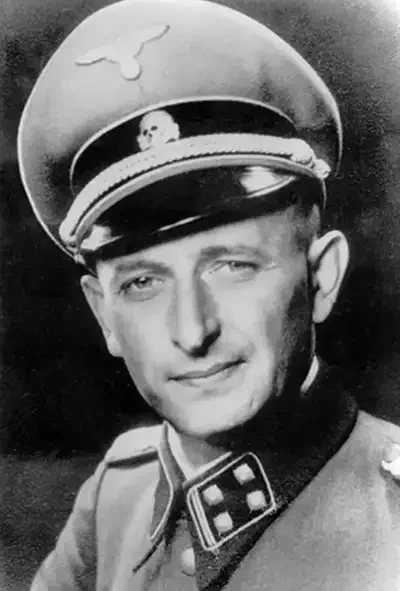- Military History
- Biographies
- Militarians Biographies
- SS-Obersturmbannführer Otto Adolf Eichmann
SS-Obersturmbannführer Otto Adolf Eichmann
Eichmann introduced the convoy systems to extermination camps and had gas chambers installed
Eichmann was a German-Austrian Nazi SS-Obersturmbannführer (Senior Assault Unit Leader) who was Head of the Gestapo’s Section IV BG, the Department of Jewish Affairs. After the Wannsee Conference (January 1942) this department was put in charge to execute the "Final Solution" what meant to extermination of all Jews. On the 1st of July 1943, Eichmann got the final decree signed by Martin Bormann, which deprived Jews of all rights of appeal. Eichmann introduced the convoy systems to extermination camps and had gas chambers installed because they were the most efficient means of execution. Although a member of the SS, he had Jewish relations and probably had a Jewish mistress when he lived in Vienna.
Born in Solingen, in the Rhineland, of a Protestant family, Eichmann was raised as a child in Linz, Austria, by a harsh stepmother. He did poorly at school, experienced unemployment and then became a traveling salesperson in Austria for the Vacuum Oil Company. In 1932, he joined the Austrian National Socialist Party, but he soon moved to Germany, where he became a member of the SS, serving for a while in the Dachau concentration camp. In 1934, he became a corporal working in the SD under Reinhard Heydrich.
Eichmann claimed after the war that he had never been anti-Semitic; indeed, he said that he was especially interested in the Jews and Jewish affairs. He learned Yiddish and had visited Palestine before the war. His concern in this period was to enforce the emigration of Jews to Palestine. His administrative abilities were recognized, and he was given charge of the Jewish section of the Gestapo and Reich Security Head Office, rising to the rank of SS lieutenant colonel. He served under Heydrich and Heinrich Müller, head of the Gestapo. After the Anschluss, he was placed in charge of the Office of Jewish Emigration in Vienna, from which over 100,000 Jews emigrated during 1938-39, leaving their wealth as plunder for the Nazis.
When interrogated in Israel after his capture in 1960, Eichmann claimed it was from Heydrich that he was informed about the "Final Solution." He organized the Wannsee Conference in January 1942 and was given the challenge of the mass deportation of Jews to the extermination camps in the east. He was the administrator of the whole genocide operation, though he was to claim that he killed no one or gave the order to do so. It was he who obeyed orders. His anti-Semitic acts, he said, were purely political, not racial, and he abominated Julius Streicher and had denounced him to the Nazi authorities.
In March 1944, Eichmann was sent to Hungary to organize the deportation to Auschwitz of the great mass of Hungarian Jews. In Budapest, he lived in the high style of a senior Nazi official until his recall in August 1944, with the gradual termination of his task in the face of the fading power of Germany. He had, in fact, been directly involved in the policy of exchanging Jewish lives for money or raw materials needed by Germany during the last stages of the war. In April 1945, he took leave of Heinrich Himmler and escaped to the south. He was for a while held prisoner by the U.S. Army, but remained unrecognized. He escaped and secured false civilian papers under the name of Otto Henniger.
He disappeared in 1945 and went to South America and settled down in Buenos Aires (Argentina) with his family. In 1960, he was discovered by Israeli agents and kidnapped during a daring commando action in Argentine territory.
Eichmann made a very full and factual confession under intense interrogation in Israel; the record of this amounts to some 3,500 pages. He was put on public trial in 1961, sentenced to death and hanged the following year on the 1st of June 1962 in the Ayalon Prison, Ramla, Israel.
Hannah Arendt, who attended the trial, described him in her book Eichmann in Jerusalem (1963) as "banal," but also as "terrifyingly normal." He was, in fact, the very model of the SS bureaucrat, the perfect deskman of death, unnerved by direct contact with violence but organizing its processes at a distance with a meticulous attention to detail.
SS-Obersturmbannführer Otto Adolf Eichmann - Quick Facts
- Germany - Weimar Republic (1919-33)
- Germany Nazi (1933-1945)
- Gestapo - Geheime Staatspolizei (German Reich)
- Kripo - Kriminalpolizei (German Reich)
- RSHA - Reichssicherheitshauptamt (German Reich)
- SD - Sicherheitsdienst (German Reich)
- SiPo - Sicherheitspolizei (German Reich)
- SS - Schutzstaffel (German Reich)
- Lieutenant Colonel
- SS-Obersturmbannführer
- {{#owner}}
- {{#url}} {{#avatarSrc}}
{{name}} {{/url}} {{^url}} {{#avatar}} {{& avatar}} {{/avatar}} {{name}} {{/url}} - {{/owner}} {{#created}}
- {{created}} {{/created}}
























